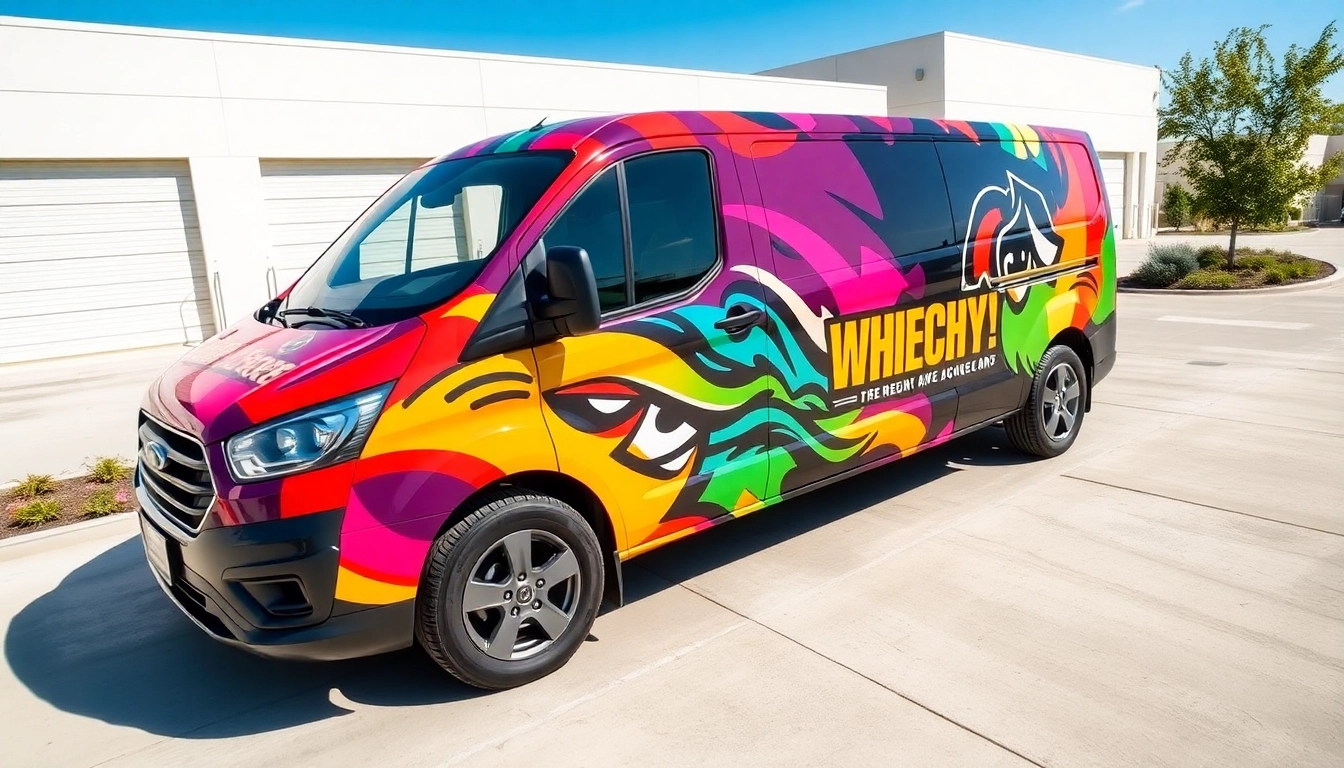Understanding Full Wrap Services
In today’s competitive landscape, businesses and individuals alike seek innovative methods for branding and personalization. One effective strategy gaining traction is the use of Full Wrap Services, which involve covering your vehicle in high-quality vinyl graphics. This transformative service not only elevates the aesthetic appeal of your vehicle but also serves as a rolling advertisement for your brand. In this comprehensive guide, we’ll dive deep into the world of full wrap services, from their benefits to the materials used, and how to choose the right design for your needs.
Definition and Benefits of Full Wraps
A full wrap refers to the complete coverage of a vehicle’s exterior with vinyl graphics. Unlike partial wraps, full wraps provide a blanket of color, graphics, and branding across the entirety of the vehicle, including the roof and bumpers. The benefits of opting for a full wrap are numerous:
- Maximized Visual Impact: Full wraps create a cohesive look, making your vehicle stand out, whether it’s parked or on the move.
- Brand Awareness: Driving around with your business’s branding plastered on your vehicle effectively turns it into a mobile advertisement.
- Protective Layer: High-quality vinyl wraps can protect the vehicle’s original paint from scratches, UV rays, and other environmental factors.
- Cost-effective Alternative: Full wraps can be a more affordable option compared to traditional paint jobs, especially when considering the potential for brand exposure.
- Easy Removal: Unlike paint, vinyl wraps can be removed without damaging the underlying surface, allowing for a complete aesthetic change if desired.
Materials Used in Vehicle Wraps
The effectiveness of a vehicle wrap largely depends on the materials utilized. Premium wraps are typically made from cast vinyl, which boasts better conformability and durability compared to calendared vinyl. Here’s a breakdown of the essential components:
- Premium Vinyl: High-quality vinyl materials are essential for a durable and eye-catching wrap. Brands such as 3M and Avery Dennison produce vinyl known for its longevity and ease of application.
- Adhesive Backing: The adhesive used must allow for a clean installation with minimal air bubbles, ensuring smooth surfaces and durability over time.
- Protective Coating: Many wraps come with a protectant layer to guard against UV rays, dirt, and environmental factors, prolonging the wrap’s life.
Types of Vehicles Suitable for Wrapping
Virtually any vehicle can benefit from a full wrap, but some types are particularly well-suited for this service:
- Commercial Fleet Vehicles: Delivery vans, trucks, and other company vehicles are prime candidates for full wraps to promote branding.
- Luxury Cars: High-end vehicles can be wrapped to customize their appearance without altering the original paint, making them unique.
- Smart Cars and Economy Vehicles: Smaller vehicles are often utilized for urban advertising and benefit greatly from the visibility of a full wrap.
- Motorcycles and Scooters: Smaller two-wheeled vehicles are also applicable for full wraps, providing branding opportunities in a compact form.
Choosing the Right Design for Your Full Wrap
The design of your vehicle wrap is crucial, as it represents your brand and communicates a message to potential customers. Here’s how to approach the design process effectively.
Elements of Effective Wrap Design
When creating a wrap design, several elements should be considered in order to make it effective:
- Branding: Integrate your business’s logo, colors, and fonts to maintain brand consistency.
- Readability: Ensure that any text is easily readable from a distance, particularly the key messages and contact information.
- Visual Hierarchy: Organize design elements based on importance, directing viewers’ attention to key aspects like the logo or promotional messages.
- Imagery: High-quality images or illustrations can capture attention, but should not clutter the design.
Custom vs. Templates: What’s Best?
Deciding between custom designs and templates hinges on your goals, budget, and brand identity:
- Custom Designs: Offer unique, personalized aesthetic that sets your vehicle apart but may incur higher costs.
- Template Designs: Generally more affordable and quicker to produce, they can still be aesthetically pleasing but may lack uniqueness.
Brand Message and Color Psychology
Understanding color psychology can greatly enhance the effectiveness of your vehicle wrap:
- Blue: Conveys trust and dependability.
- Red: Evokes excitement and urgency.
- Green: Signifies health and tranquility.
- Black and Gold: Represents luxury and sophistication.
Choosing a color that resonates with your target audience and effectively communicates your brand message is essential for maximizing impact.
The Process of Getting Full Wrap Services
Understanding the process of getting a full wrap will streamline your experience, from conception to installation.
Steps Involved in Vehicle Wrapping
The following steps outline the typical journey of obtaining and installing a full vehicle wrap:
- Consultation: Initially, you’ll meet with a wrapping professional to discuss your vision, goals, and budget.
- Design Phase: An artist or designer will create mock-ups based on your ideas and branding.
- Material Selection: Choose the type of vinyl that best suits your needs based on durability and color.
- Preparation: Your vehicle will be cleaned and prepped to ensure the vinyl adheres properly.
- Installation: Professionals will meticulously apply the wrap to ensure a flawless finish.
- Quality Check: After installation, a review is conducted to guarantee precision and alignment with design specifications.
- Post-installation Care: You’ll receive guidelines on how to maintain your wrap for longevity.
Preparing Your Vehicle for a Wrap
Preparation is critical to a successful wrap installation. Here are a few steps to consider:
- Thorough Cleaning: The vehicle should be washed and dried to remove surface contaminants.
- Inspect for Damage: Any existing scratches or dents should be repaired, as they may negatively affect the wrap’s appearance.
- Remove Accessories: Items such as antennas, decals, or trim should be removed to allow for seamless coverage.
Installation Tips from Professionals
To ensure a quality installation, consider the following tips from wrap experts:
- Temperature Control: Install the wrap in a controlled environment; avoid extremes of heat and cold.
- Use the Right Tools: A professional should use specialized tools to ensure a precise application.
- Check Each Area: Regularly evaluate each section during application to ensure there are no bubbles or wrinkles.
Maintenance Tips for Long-lasting Wraps
Maintaining your vinyl wrap is essential for extending its lifespan and keeping it looking fresh.
Daily Care Practices for Your Wrap
Here are some simple, everyday maintenance tips to follow:
- Regular Washing: Gently wash your wrap with mild soap and a soft cloth to remove dirt and pollutants.
- Avoiding Automatic Car Washes: Brush wash systems can damage the wrap; always opt for hand washing.
- Apply a Sealant: Use a vinyl-safe wax or sealant to provide additional protection against UV rays and scratches.
Understanding How to Remove a Wrap Safely
When it’s time for a new wrap or if you wish to revert to your vehicle’s original paint, here’s how to safely remove a wrap:
- Heat Application: Use a heat gun to warm up the vinyl slightly, making it easier to peel away.
- Peeling at an Angle: Slowly pull the vinyl at a 180-degree angle to prevent damage to the paint beneath.
- Cleaning Residue: After removal, any adhesive residues can be wiped clean with an adhesive remover.
Signs It’s Time for a New Wrap
Identifying when to replace your vehicle wrap is essential for maintaining a professional appearance. Here are some signs to look out for:
- Peeling or Cracking: If you observe significant damage or wear, it’s time to consider a replacement.
- Fading Colors: Exposure to UV rays can cause vinyl colors to fade over time.
- Increased Maintenance Needs: If upkeep becomes frequent and difficult, a new wrap may be more beneficial.
Cost Considerations for Full Wrap Services
Understanding the financial implications of full wrap services helps in budgeting and selecting the right options.
Factors Influencing the Price of Wraps
The cost of a full wrap can vary due to several factors:
- Vehicle Size: Larger vehicles naturally incur higher costs due to the additional material required.
- Design Complexity: Custom or intricate designs will generally cost more than simpler, template-based options.
- Material Quality: Higher-quality vinyl materials will increase overall costs but provide better longevity and appearance.
Comparing Costs: Full vs. Partial Wraps
When considering wraps, understand the differences in pricing and value:
- Full Wraps: Typically range from $2,000 to $5,000, depending on the vehicle and customization.
- Partial Wraps: These generally cost less but may not provide the same level of impact for branding.
Choosing the right option depends on the goals and budget set for vehicle branding.
Finding the Right Balance: Quality vs. Budget
While it’s tempting to opt for the lowest price, consider quality as a priority. Here’s how to balance your budget with quality needs:
- Research Providers: Look for reputable wrap companies with positive reviews and a portfolio of previous work.
- Request Quotes: Gather multiple quotes to better understand pricing and included services.
- Inquire About Guarantees: Ensure that the wrap services come with a warranty for added peace of mind.


